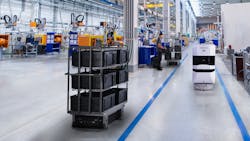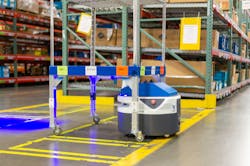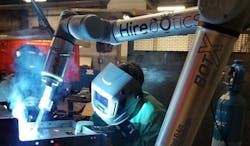With good welding, stamping, and operator help being hard to find, Processed Metals Innovators (PMI), a steel fabrication facility, saw industrial robots as a workaround for its staffing problem. Yet its past method of procuring robots as a traditional capital expense didn’t consistently prove to be a reliable investment.
“We had a traditional welding robot cell that sat around for the better part of three years because we didn’t have a job for it,” recounts Erik Larson, vice president of operations for PMI. “If you own robots, you have a lot of money tied up in something you’re not always using.”
Rather than ditch the idea of using industrial robots to pick up the slack and augment his current crew, Larson turned to Hirebotics, a newcomer on the industrial automation scene. Hirebotics is among a growing pool of entrants pioneering a new approach to industrial robots called robotics-as-a-service (RaaS). Much like the popular software-as-a-service model in enterprise IT, RaaS shifts a traditional capital expenditure (CapEx) to an operational expenditure (OpEx), allowing firms like PMI to deploy industrial robots without hefty upfront costs. In many cases, RaaS can be rolled out at a significantly quicker pace since the systems typically don’t require the custom programming and lengthy consulting engagements that characterize traditional industrial robot deployments.
In addition, RaaS offerings like Hirebotics generally encompass a cloud platform, mobile apps, and analytics tools used to facilitate management of the robot, including delivery of software updates, diagnostics and maintenance help as well as to deliver data-driven insights that optimize the robots’ efficiency, quality of work, and performance.
While still in the early days, the RaaS installed base is growing quickly, particularly for applications in manufacturing, logistics, and hospitality, according to ABI Research. ABI Research estimates that the installed base for RaaS will grow from 4,442 units in 2016 to 1.3 million in 2026, with annual revenues surging from $217 million in 2016 to nearly $34 billion over the decade. The transition to RaaS is a win-win for manufacturers and robotics vendors, contends ABI Research Analyst Rian Whitton: RaaS essentially eliminates the need for third-party system integrators while creating a value-added revenue stream for robotics makers, he says.
“RaaS is seen as the great simplification of the value chain,” Whitton explains. “It takes third parties out of the process and creates a duopoly between the customer and the robotics manufacturer, which is now a service provider.” For customers, the RaaS model significantly lowers the initial barriers to adoption, including large-scale capital investments and the need to engage with a number of players during deployment, from the robotics OEM to systems integrators and service providers. For robotics vendors, the model provides a way to offer customers additional services and cultivate new revenue streams.
The upside of RaaS
The benefits of procuring the BotX robotic welder through a RaaS model were many for PMI. Not only can the company purchase the welding robot without a significant capital investment, it doesn’t need to maintain on-staff expertise to program and support the robot. This is especially significant given that PMI is a job shop, meaning it continuously needs to change out fixtures to accommodate different projects—a scenario that would typically increase reliance on custom robotics programming and configuration, Larson says.
Larson also finds value in the Hirebotics’ experience, which aims to make the process of bringing on a robot akin to hiring a human worker. Hirebotics robots, which are managed and serviced remotely through a cloud-based platform and mobile app, are procured with a pricing model that charges for the time the robot is used and, more importantly, relative to its productivity. As a result, Larson says PMI can scale up the number of robots needed to meet demand but can just as easily back down capacity when and if it doesn’t need additional labor assistance.
“If we get really busy, we can get another robot within two or three weeks and get them on the floor,” he explains. “If we slow down, we have peace of mind that we can get rid of them with 30 days’ notice…and they’re not just sitting there for three years.”
Simplifying the deployment of robots and automation lies at the heart of the Hirebotics’ RaaS vision. The company touts its cloud platform as a key differentiator, allowing for easy distribution of upgrades and providing a remote connection to the robot to aid in performance monitoring and problem resolution.
“We fundamentally believe most companies shouldn’t own robots just like they don’t own servers in the IT space,” says Rob Goldiez, the company’s co-founder and CEO. “Hirebotics is a good fit when the customer doesn’t have experience in automation in house or their automation teams are just too busy and don’t have time to support another project. If there’s a problem in the middle of the day or night, Hirebotics is on the hook to deliver support.”
Goldiez also makes a point to differentiate Hirebotics’ RaaS model from competitors offering leasing programs for industrial robots. “With a three-year lease, you effectively own the robot after that time period,” he says. “If our robots don’t perform, that robot can get fired for cause—that is the key difference.”
Fetch Robotics, another player in the emerging RaaS space, touts its on-demand automation model as an offering for the critical pain points surrounding automation, which according to CEO Melonee Wise, is time to deployment and time to value.
Fetch robots can be deployed in a production or logistics facility in as little as eight hours without having to install dedicated Wi-Fi or on-premises servers, which can introduce additional security risks. Fetch robots also don’t require integration with warehouse management systems or other platforms for operations (although there are application programming interfaces available that can help facilitate such integration), can be re-purposed by users, and can be scaled, Wise claims. “One of the biggest problems with automation is it takes months to spec out, several months to deploy, and integration can cost hundreds of thousands of dollars,” Wise says. “On-demand automation reduces the total risk to customers so they can get fast wins.”
Fetch’s RaaS model also gives customers access to the latest technology since software updates and feature enhancements are regularly disseminated via a cloud-based platform. Another upside is the more sustainable business model RaaS suppliers like Fetch Robotics provide by refurbishing and reintroducing robots back into their on-demand fleets for other customers. “It’s a game changer in terms of offering a business model that allows customers to stay up to date with technology and equipment,” Wise says. “It also reduces the ecological footprint, which is something more companies are focused on today.”
Universal Logistics, a provider of customized transportation and logistics services, is experimenting with Fetch robots and the RaaS model, initially in its Smyrna, Tenn., facility, which houses automotive parts for Nissan Motor. The Fetch robots ferry carts between the areas where parts are sorted and the loading docks where they are transported, replacing human workers that have traditionally been mired down with non-value added tasks like running parts around a 1-million-square-foot facility. With the Fetch model, Universal Logistics is currently able to handle 40 carts with 10 robots as part of two workflows.
“We want to keep the operators in the work area because whenever they leave it, there is no value and no revenue generated,” notes Lee Weisenberger, the company’s managing director of IT. While one Fetch robot is doing the work of two human laborers, Weisenberger says the purpose of the robots isn’t to reduce the total head count, but rather to redeploy workers to higher value tasks and to help the company work through its on-going staffing challenges.
“RaaS helps me go from zero to full implementation without worrying about the cost,” he says. “If the vendor doesn’t come through, we’re not out a million dollars.” A RaaS model also ensures Universal Logistics doesn’t get stuck with outdated technology. “I anticipate these robots will be obsolete in three or four year and we’ll be in the position of wanting to trade up,” Weisenberger says.
Questions to consider
While there’s plenty of upside to the RaaS model, it’s not a fit for every company and every industrial robotics application. Experts suggest companies examine the total cost of ownership and return on investment (ROI) of their existing legacy equipment along with their past history of maintenance to get a handle on whether an RaaS offering can mitigate some of those costs and challenges. Additionally, companies need to consider if they have the on-site talent that can be dedicated to supporting and programming industrial robots—if they don’t, the RaaS model might be an effective answer, they say.
Vendor lock-in is another issue to evaluate when considering RaaS, because you are entrusting hardware, software, system integration, and data analytics services to a single provider. “Perhaps they don’t have things tailored to the way you want,” ABI’s Whitton explains. “You can’t choose different providers for different things.”
Sarcos Robotics, which offers a family of industrial robots, is looking at RaaS only for its newest entry—the Guardian XO exoskeleton suit that improves human strength and endurance and is due to market by the end of this year. Unlike its other robots, the Guardian XO is well suited for RaaS because it doesn’t demand a lot of customization to run effectively, unlike other robots in the Sarcos family.
“If I spend $20,000 customizing a robot, it’s not going to work for a RaaS or leasing model because I’d have to find another customer with the same customization need,” says Ben Wolff, Sarcos Robotics CEO. Nevertheless, RaaS makes sense for robots like Guardian XO because it reduces the barrier to entry, since companies don’t have to incur a big upfront expense.
Aethon, maker of the TUG autonomous mobile robot, doesn’t formally bill the robot as being available as RaaS even though it offers its products as a subscription service and supports the robots with a centralized command center that allows it to offer value-added services. For example, the command center is used to monitor and support the robots, including employing algorithms and data-driven analytics to proactively determine when to send maintenance crews out for service. “This takes all the burden and obligation away from the customer compared to a traditional [robotics] model,” which relies on the manufacturer or a systems integrator, says Peter Seiff, Aethon’s senior vice president of business development.
Aethon shies away from labeling its offering as RaaS because customers don’t yet have a clear understanding of the category and because there’s a unit of measurement tied to the service, which Seiff argues could discourage use. “Sometimes an as-a-service model is a disincentive for customers using the product to its fullest capacity,” he says. “If you’re charging based on the runs accrued or time used, we think that’s counterproductive. We want our customers to use the product as much as they can.”
Seiff also believes some companies are initially attracted to RaaS because they want to give themselves an easy out. “If a product feels risky and that’s why you’re attracted to a RaaS offering, then perhaps you need to take a step back and see if there are more proven products,” he says.
About the Author
Beth Stackpole, contributing writer
Contributing Editor, Automation World

Leaders relevant to this article:



